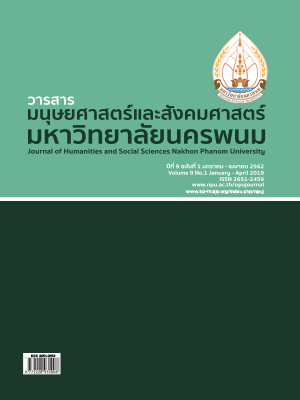Factor Analysis of the Attitude towards fraud Risk factors for a Good Internal Control System
Main Article Content
Abstract
The purposes of this study were to investigate: 1) risk factors environment 2) types of risk factors on Fraud in social A population of study was auditor 760 and regional inspector general no.1 - 15 regional special audit office no.1 – 15 total 775. The instruments used was In-depth Interview and a 5-rating scale questionnaire whose items of risk factors had discrimination power values ranging between 0.451 – 0.739 and all inter – item correlation exceeded 0.4. Statistics used in data analysis were exploratory factor analysis by Principal component Analysis.
The findings disclosed as follows: Model of fraud risk factors Include 1. compliance risk factors 2. Personal risk and 3. Internal control risk which three risk factors comply with dimension of the committee of sponsoring organizations of the treadway commission (COSO) so that researcher present guidelines for taking advantage of risk factors from this research to data basic in audit planning of internal and external auditor to auditing efficiency However executive and every employee should be important with good internal control system.
Article Details
References
Committee of Sponsoring Organizations of the Treadway Commission (COSO). (2015). Guidance on internal control: Internal control framework 2013. Retrieved April 15, 2018, from https://www. coso.org.
Glaser, B.G., & Strauss, A.L. (1967). The Discovery of Grounded Theory: Strategies for Qualitative Research. New York: Aldine De Gruyter.
Habib, A., & Hossain, M. (2013). CEO/CFO Characteristics and fi nancial reporting quality: A review.Research in Accounting Regulation, 25(1), 88-100.
Heidenheimer, Arnoid J. (1989). Political Corruption : Readings in Comparative Analysis New York : Holt, Rinehart and Winston, Inc.,.
Hopwood, W. S., Leiner, J. J. & Young, G. R. (2009). Forensic accounting. International edition. McGraw-Hill.
Klitgard, Robert. (1999). Controlling Corruption. University of California Press.
Lamoureux, M. (2013). Internal controls handbook: The power sector and NERC compliance. North Charleston: CreateSpace Independent Publishing Platform.
Rittenberg, L. (2013). COSO Internal control-integrated framework: turning principles into positive action. Altamonte Springs, Florida: The Institute for Internal Auditors Research Foundation.
Singleton, T. W., Singleton, A., Bologna, J., & Lindquist, R. (2006). Fraud auditing and forensic accounting. New York: John Wiley & Sons.
Williams, Robert J. (2000). Explaining Corruption. The Politics of Corruption 1 Cheltenham: Edward Elgar Publishing.
Wright, R. A. (2013). The internal auditor’s guide to risk assessment. Altamonte Springs, Florida: The Institute for Internal Auditors Research Foundation.


